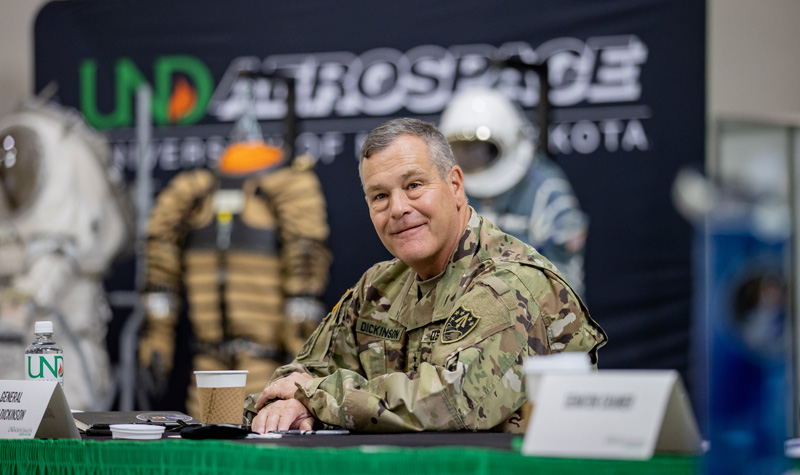Learn To Fly Helicopters With UND Aerospace (Helicopter Nation, 10/22/15: Tom Ordonez)
Wes Van Dell is one of the senior helicopter flight instructors at UND Aerospace.
Can you please give us a summary about your career?
After graduating from UND in 2006, I moved to southern California to begin my career.
I was working as a contract pilot for SRT Helicopters located in Bakersfield, CA flying the 269C and B206.
MY FIRST PROFESSIONAL JOB WAS A CHERRY DRYING CONTRACT THAT LASTED FOUR DAYS. IT WAS GREAT EXPERIENCE FOR A LOW TIME PILOT.
While working on various contracts I was also training for my CFI and CFII ratings in Long Beach with LA Helicopters.
The busy airspace was challenging but it was a beautiful place to fly. In one flight you could go from the beach, to the hills, to the desert, to the mountains and back again.
After obtaining my CFII, I was offered a full time instructor position back at UND Aerospace. I was hired on as a flight instructor, and have since become a standardization pilot and evaluation pilot.
Working for such a large flight school like UND presented other unique opportunities as well. I have been the safety representative for the helicopter department since 2009 and part of the SMS implementation team, a first for part 141 flight schools.
What was the process of getting your CFI and CFII?
My CFI certificate was not required for me to graduate from UND.
After graduation, I felt the need to challenge myself with a different airspace and different aircraft. Since all my training had been in the S300C and the Bell 206 helicopter, I wanted to get my SFAR training in Robinson aircraft and achieve my CFI and CFII at the same time.
MY INSTRUCTORS AT LA HELICOPTERS WERE CLOSELY INTEGRATED WITH THE ROBINSON SAFETY COURSE, SO THE TRAINING WAS INVALUABLE.
How To Become A Pilot
Being a helicopter pilot is a challenging and rewarding career that can take you anywhere you want to go. There are many scholarships available to help with the cost of flight training. Think of it as an investment in your future, and one that is well worth making.
Although it costs more than fixed wing training, rotor wing jobs typically have a much faster rate of return. Once you have your ratings, be as flexible as you can. Don’t expect to get a job in your home town right away. You may have to move across country to get your first job.
Attitude is a huge factor as well. Don’t expect to get hired just because you meet the minimum requirements. Show a positive attitude, be willing to do the little jobs, and you will go far.
Learn To Fly Helicopters With UND Aerospace
UND AEROSPACE HAS BEEN TRAINING HELICOPTER PILOTS FOR MORE THAN 30 YEARS.
Over that time, the demographics have changed quite a bit. Originally, the program trained primarily military cadets as part of the Army ROTC Helicopter Flight Training Program (HFTP) scholarship.
We have also trained pilots for Saudi Aramco, Saudi Ministry of Interior, and Customs and Border Protection to name a few.
Recently our demographic has changed to a majority of commercial undergraduate training.
This year we have the largest number of non-contract undergraduate students in the history of the program.
Helicopter Pilot Jobs
Most likely after you finish your ratings you will flight instruct for a year or two to build your initial time. This is not a requirement, but typical for most students.
ONCE YOU HIT 1000 HOURS PIC IN HELICOPTERS YOUR CAREER OPTIONS START TO OPEN UP.
Many of our instructors go to the Grand Canyon or NYC to fly for tour operator’s right when they hit that mark. Some also go on to fly SIC in the Gulf of Mexico.
From there the typical progression is to move into HEMS or PIC in the off shore oil industry.
We have many students serving these sectors, as well as flying around the world in virtually every facet of the helicopter industry.
What advice would you give to helicopter pilots when they must transition from VFR to IFR?
Getting your instrument rating in helicopters is not as common as with fixed wing pilots.
Fewer operators fly IFR due to the complexity of IFR certified helicopters. There is a point in your career, however, that having your instrument rating will be essential for that next career step.
Regardless of requirements, being an instrument rated pilot will make you a better pilot even for VFR flying. Since there is no inherent stability in helicopters, inadvertent IMC can be deadly.
Having the instrument rating, being able to transition quickly to an instrument scan may make the difference. At UND Aerospace, we require that our students get their instrument rating before they graduate for those reasons.
What advantages do you consider training on an S-300 over a Robinson 22?
The S300 helicopter was designed from the ground up as a training helicopter. Its stability, durability, flight controls, and survivability make it the ideal airframe for all levels of training.
At UND we train to do touchdown autorotations, LTE and anti-torque failures, as well as a variety of other emergency procedures in every training course. Having a rugged and forgiving airframe to practice on is essential for those tasks.
This also gives us additional confidence when a student is making a solo flight. Not having special training restrictions or SFAR’s to deal with is another added bonus.
Can you please tell us about the transition from S-300 to Bell 206?
Transitioning into the Bell 206 helicopter requires quite a bit of systems and emergency procedure familiarization prior to beginning flying.
Because of this, at UND we integrate ground training into our turbine transition course.
Flying the Bell 206 helicopter is not too dissimilar to flying the S300. The biggest differences involve the hydraulic flight controls and the semi rigid rotor system.
Transitioning into hydraulics takes some getting used to, since all the feedback and connection you feel with un-assisted controls is removed. A semi rigid rotor also responds differently than a fully articulated system.
Pilots tend to over control initially, forcing students to lighten their control touch to compensate.
Wes Van Dell
Wes Van Dell is one of the senior helicopter flight instructors at UND Aerospace. He is a CFI and CFII helicopter pilot with 2,000 hours of flight training experience in the S300 and Bell 206 helicopter.


